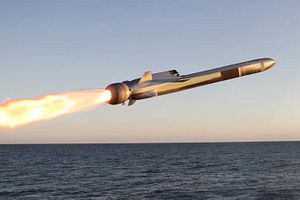Norway-based Kongsberg Gruppen and U.S. missile maker Raytheon Company have been selected by the U.S Navy to supply the service with the fifth-generation over-the-horizon Naval Strike Missile (NSM) for its fleet of Littoral Combat Ships (LCS) and future frigates, according to a June 1 statement.
“Raytheon will manufacture and deliver the over-the-horizon weapon systems under a $14.8 million contract for offensive missiles loaded into launching mechanisms, and a single fire-control suite,” the statement published by the U.S. defense firm said. “The contract includes options which, if exercised, would bring the cumulative value to $847.6 million.”
The NSM is the successor to Kongsberg’s Penguin short-to-medium range anti-ship guided missile. The missile, featuring an imaging IR-seeker and inertial/GPS navigation, can strike both sea and land targets at a distance of around 185 kilometers (100 nautical miles). Carrying a 125-kilogram (276 pounds) multi-purpose blast/fragmentation warhead, the NSM is capable of reaching high subsonic speeds and can approach its targets in sea skim mode.
The missile also reportedly uses a built-in database of representative ship types in order to automatically discriminate between the intended target and other objects.
The missile will be likely placed on the decks of LCSs and frigates in proprietary canister launchers. According to Raytheon, NSM launchers, the missile itself as well as other components will be manufactured the United States. By 2023, the U.S. Navy intends to procure a total of 64 NSMs. A LCS will be capable of carrying up to eight NSMs in deck-mounted canisters.
As I reported previously, the U.S. Navy still lacks an adequate long-range, anti-ship missile to implement a re-organization of the surface fleet based on the ‘distributed lethality’ concept of operations (see: “The US Navy’s New Surface Warfare Strategy: ‘Distributed Lethality’”). “The aging anti-ship missiles currently in use — including the Boeing RGM-84 Harpoon Block II and the French-designed MBDA Exocet — no longer fulfill the operational requirements set out in the navy’s new more aggressive warfighting strategy,” I noted.
LCSs will also be armed with the RGM-84D Harpoon Block 1C. A NSM was test-fired from the Independence-class LCS USS Coronado in 2014. (Boeing and Lockheed Martin offering an upgraded variant of the Harpoon and the Long-Range Anti-Ship Missile dropped out of the competition for the LCS and future frigate contracts in May 2017.)
The U.S. Navy commissioned its latest littoral combat ship (LCS), the Independence-class USS Manchester (LCS-14) in late May. The Freedom-class USS Milwaukee (LCS 5) conducted a live-fire missile exercise last month to test the so-called Surface-to-Surface Missile Module (SSMM), a 24-shot vertical launch system designed to engage smaller surface targets in close proximity to the LCS with AGM-114L Longbow Hellfire missiles. The SSMM is expected to achieve initial operational capability in 2019 and will be installed on all LCSs.
Twenty-nine LCS contracts have been awarded to date with 13 ships delivered to the U.S. Navy as of May 2018. Beginning in 2020, the service intends to shift from LCSs to procuring new multi-mission guided-missile frigate with the notional designation FFG(X).
































